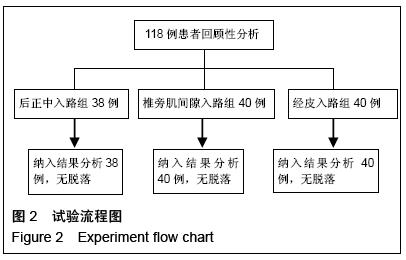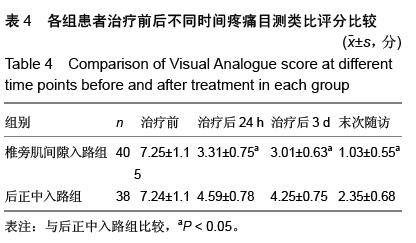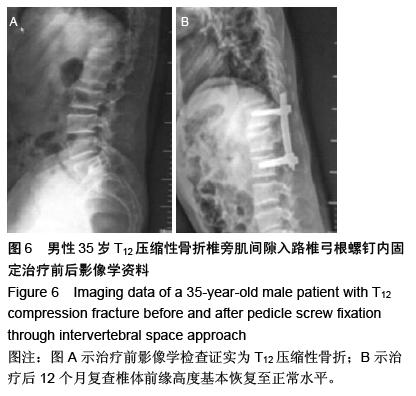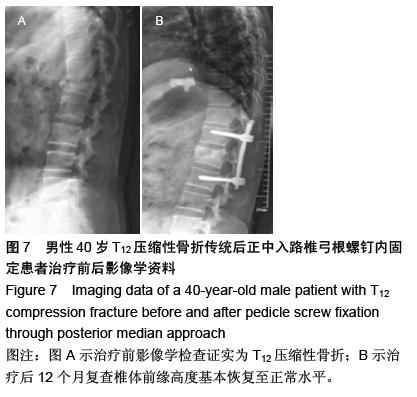| [1] 马晋,孙春汉,郑剑平,等.应用后路经椎旁肌间隙入路椎弓根螺钉内固定结合手法复位治疗胸腰椎骨折的疗效观察[J].航空航天医学杂志,2014,25(10):1359-1361.
[2] 侯德胜,王恒,仲文军,等.体位复位结合椎旁肌间隙入路治疗胸腰椎骨折[J].实用骨科杂志,2013,19(2):99-102.
[3] 王静雅,邓雪飞,廖文斌,等.胸腰移行部椎旁肌间隙的解剖及临床应用研究[J].安徽医科大学学报,2015,50(2): 164-167,168.
[4] 滕红林,吴哲褒,吴春雷,等.经椎旁肌间隙入路治疗胸腰椎椎间孔哑铃形肿瘤[J].中华神经外科杂志,2011,27(9): 894-897.
[5] Kawaguchi Y, Matsui H, Tsuji H. Back muscle injury after posterior lumbar spine surgery. A histologic and enzymaticanalysis. Spine. 1996;21(8):941-944.
[6] Wiltse LL, Bateman JG, Hutchinson RH, et al. The paraspinal sacrospinalis- splitting approach to the lumbar spine. J Bone joint Surg Am. 1968;50: 919-926.
[7] 李俊,王江南,沙玉山,等.椎旁肌间隙入路经椎弓根内固定治疗胸腰椎骨折[C].//安徽省医学会骨科学第十三次学术会议论文集,2012:328-330.
[8] 卢荣,陈建,赵存赛,等.肌电图评价不同手术入路治疗脊柱胸腰段骨折对椎旁肌功能的影响[J].宁夏医科大学学报, 2014,36(8):876-878,882.
[9] Jindal N, Sankhala SS, Bachhal V, et al. The role of fusion in the management of burst fractures of the thoracolumbar spine treated by short segment pedicle screw fixation: A prospective randomised trial. J Bone Joint Surg. 2012;94/B(8):1101-1106.
[10] 刘侃,吴闻文,郭继东,等.经Wiltse肌间隙入路内固定结合椎体内植骨治疗胸腰椎骨折的早期疗效观察[J].中国骨与关节外科,2013,(4):349-354.
[11] 刘玖行,龙亨国,丁永志,等.肌间隙入路单节段内固定治疗简单胸腰段骨折[J].浙江创伤外科,2011,16(3):407-408.
[12] 辛荣超,白永鑫.胸腰椎骨折经Wiltse肌间隙入路与传统入路的临床对比研究[J].内蒙古医学杂志,2014,46(8): 897-900.
[13] 谭健,李平元,卢政好,等.经椎旁肌间隙与后正中入路取出胸腰段椎弓根螺钉内固定系统疗效的比较[J].中南医学科学杂志,2014,42(4):399-401.
[14] 王延国,鲁秀国,周忠水,等.椎旁肌间隙入路结合术前手法复位治疗胸腰椎骨折[J].脊柱外科杂志,2013,11(3):137-140.
[15] 汪冉,杨永宏,郑杰,等.后路经椎旁肌间隙椎弓根螺钉内固定术治疗胸腰椎骨折[C].//第五届全国创伤骨科学术会议论文集,2012:1-4.
[16] 韩雷,全仁夫,孙观荣,等.椎旁肌间隙入路结合伤椎单侧置钉固定治疗胸腰椎骨折[J].中国骨伤,2014,27(5):395-399.
[17] 杨洪宇,欧云生,权正学,等.比较经椎旁肌间隙入路与传统开放入路置入椎弓根螺钉治疗胸腰椎骨折的疗效[J].中国现代医学杂志,2011,21(27):3421-3424.
[18] 任忠明,吴宏飞,张远,等.肌间隙入路与传统入路椎弓根螺钉内固定治疗胸腰椎骨折[J].中华创伤杂志,2013,29(9): 845-848.
[19] 徐明伟.不同手术入路治疗无神经损伤的胸腰椎骨折的近期疗效观察[J].岭南现代临床外科,2014,14(5):553-556.
[20] 韦盛,李兴艳,程浩,等.经椎旁肌间隙与后正中入路治疗113例胸腰椎骨折的对比研究[J].骨科,2014,5(3):136-139.
[21] 李玉茂,王剑火,林奇益,等.椎旁肌间隙入路与传统后入路在胸腰椎骨折后路手术中的比较[J].颈腰痛杂志, 2012, 33(5):340-344.
[22] 张兆川,马超,吴德慧,等.椎弓根螺钉椎旁肌间隙与后正中入路内固定修复胸腰椎骨折:稳定性比较[J].中国组织工程研究,2014,18(40):6451-6458.
[23] 赵斌,赵轶波,马迅,等.经椎旁肌间隙入路在胸腰椎骨折治疗中的应用[J].中华骨科杂志,2011,31(10):1147-1151.
[24] 林达生,郭林新,丁真奇,等.椎旁肌间隙入路经伤椎椎弓根植骨内固定治疗胸腰椎骨折[J].中华外科杂志, 2011, 49(2):125-129.
[25] 陈晓陇,尚平,温月凤,等.椎旁肌间隙入路与传统后正中入路在胸腰椎后路手术中的应用比较[J].中国脊柱脊髓杂志,2012,22(10):925-930.
[26] Shim JH,Kim WS,Kim JH,et al.Comparison of instrumented posterolateral fusion versus percutaneous pedicle screw fixation combined with anterior lumbar interbody fusion in elderly patients with L5-S1 isthmic spondylolisthesis and foraminal stenosis. J Neurosurg Spine. 2011;15(3):311-319.
[27] 王诗成,黄必留,潘磊,等.经肌间隙入路短节段椎弓根钉置入修复胸腰椎骨折:损伤节段Cobb’s角变化[J].中国组织工程研究,2015,19(13):2045-2050.
[28] 李玉伟,严晓云,王海蛟,等.经椎旁肌间隙入路内固定结合伤椎椎体内植骨治疗胸腰椎骨折[J].中国脊柱脊髓杂志, 2013,23(11):1040-1042.
[29] 韩雷,全仁夫,毕大卫,等.经椎旁肌间隙入路单侧伤椎置钉联合短节段椎弓根螺钉复位固定治疗胸腰椎骨折临床观察[J].中华全科医师杂志,2014,(5):393-395.
[30] 张琼美,孙俊明,刘德美,等.经椎旁肌间隙行后路椎弓根螺钉内固定术治疗胸腰椎骨折的效果观察[J].中国当代医药,2014,21(20):41-42,45.
[31] 刘岩,吴立君,宋正鑫,等.椎旁肌间隙入路短节段固定并经伤椎置入硫酸钙治疗胸腰段椎体骨折[J].临床和实验医学杂志,2015,14(10):805-808.
[32] 李俊,王江南,沙玉山,等.椎旁肌间隙入路经椎弓根内固定治疗胸腰椎骨折[J].实用骨科杂志,2011,17(9):777-779.
[33] Kotil K, Ali Akçetin M, Sava? Y. Clinical and radiologic outcomes of TLIF applications with or without pedicle screw: A double center prospective pilot comparative study. J Spinal Disord Tech. 2013;26(7):359-366.
[34] 赵明伟,杨素珉,周伟东,等.棘突旁小切口经多裂肌间隙入路多节段固定在腰椎结核后路手术中的应用[J].中华临床医师杂志(电子版),2014,8(23):4177-4181.
[35] Kose KC, Inanmaz ME, Isik C, et al. Short segment pedicle screw instrumentation with an index level screw and cantilevered hyperlordotic reduction in the treatment of type-A fractures of the thoracolumbar spine. Bone Joint J. 2014;96-B(4):541-547.
[36] 唐国军,申佳凡,唐晓军,等.椎旁肌间隙入路经伤椎内固定术结合局部浸润麻醉治疗胸腰椎爆裂骨折临床疗效分析[J].社区医学杂志,2015,13(4):6-8.
[37] Rihn JA. Commentary: Is bilateral pedicle screw fixation necessary when performing a transforaminal lumbar interbody fusion? An analysis of clinical outcomes, radiographic outcomes, and cost. Spine J. 2012;12(3):216-217.
[38] 杨洪宇.比较经椎旁肌间隙入路与传统开放入路置入椎弓根螺钉治疗胸腰椎骨折的疗效[D].重庆医科大学,2012.
[39] 梁珪清,刘伯龄,李照辉,等.椎旁肌间隙入路椎弓根螺钉治疗胸腰段椎体骨折的体会[J].中国药物与临床, 2012, 12(11):1474-1475.
[40] 黄卫,李新志,卢国强,等.椎旁肌间隙入路(Wiltse入路)并结合伤椎椎弓根钉棒系统固定在无神经症胸腰椎骨折后路手术中的临床应用研究[C].//第三届全国创伤急救与多发伤学术会议论文集,2014:149-150. |
.jpg)




.jpg)
.jpg)

.jpg)


.jpg)